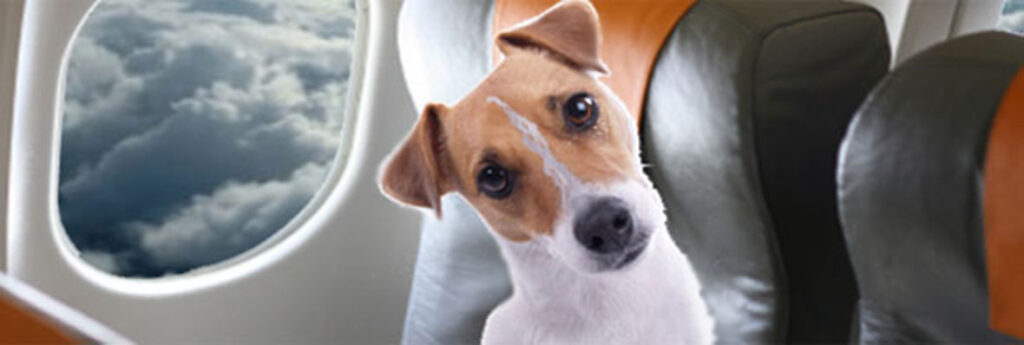Approximately 40 percent of pet owners include their pets in travel plans – and that number is growing, having doubled in the last decade, according to the recent American Pet Products Association’s ‘National Pet Owner’ survey. But flying with Fido doesn’t come without considerable circumstance and planning.
With this in mind, here is a list of do’s, don’ts and must-do’s to help keep dogs – and their parents – stress-free while flying, with advice from the government of Canada, and from veterinarian Dr. Jo Myers of the animal telehealth platform Vestser.
Before you fly
Air travel takes a good bit of planning whether or not you’re bringing your dog. In a sense, everything you bring for yourself you have to bring a dog version of for them – plus additional dog-specific items.
Visit your vet
Start early: Most pets travelling from Canada to another country will need an export certificate issued by a licensed veterinarian and endorsed by an official Canadian Food Inspection Agency (CFIA) veterinarian. It is mandatory to obtain CFIA endorsement of an export certificate before the animal(s) leave Canada as the CFIA cannot endorse or issue a certificate if the animal(s) is/are no longer in Canada.
The requirements for pets travelling to another country are very specific and different for each country (including the US). As a pet owner, you must plan ahead to ensure you have enough time to meet any testing, vaccination, or treatment requirements and obtain the necessary certifications. Some countries may also require owners to obtain an import permit in addition to an export certificate.
Health certificates have expiration dates, so it’s important to get the timing right. You’ll also want the peace of mind of knowing your pet has been thoroughly checked over and is ready for travel. This is also the perfect opportunity to ask about options that may help your pet cope with the stress of travel. Dogs who are prone to GI upset with stress, for example, might benefit from starting a probiotic a day or two before the trip.
Call the airline
Each airline has its own set of rules and requirements, so get in touch with them well in advance so you won’t have any surprises. For example:
• Many airlines limit the number of pets that can travel in the cabin.
• You can also expect to be required to present your dog’s health certificate to airline staff at the check-in counter and have a signed letter of acclimation from a veterinarian.
• They also may not allow pets to travel during extreme weather, especially if they won’t be in the cabin with you.
• If your dog takes regular medication, make sure you have enough to get through your travel period in your carry-on.
Choose a travel carrier
Your dog’s carrier must meet certain size requirements in order for your pup to travel with you in-cabin. For pets travelling cargo, allowed kennel dimensions are somewhat larger, as many people choose to fly large-breed dogs this way.
• Regardless of an airline’s specific size requirements, all carriers must be ventilated and large enough for your dog to comfortably sit, stand, and turn around in.
• The carrier should be secure so the animal cannot escape or be injured, but still provide adequate ventilation.
• Speak to your veterinarian if you are unsure about what type of carrier you should use for your pet.
• Dogs are not allowed out of their carriers at any time, either in cargo or in-cabin.
What to pack
In addition to medications and vet documentation, you’ll want to be sure you pack the essentials, even on a short flight: food, water, pee pads, doggie bed, calming collar or shirt, toys, chews, identification, collar, and leash.
Keeping your dog comfortable during flight
Even for a well-travelled dog, flying can be uncomfortable, stressful, and just downright boring. You’ll have to do your best to keep them comfortable, while strictly observing certain airport and airline restrictions. Getting a calming collar (an anxiety management tools that emits a pleasant scent or release pheromones that mimic the soothing hormones mother dogs produce) may help. A favourite blanket or familiar toy can work, too.
Here is a list of Dos and Don’ts when bringing your pet on the plane:
Do
• Remove your pet from its carrying case and send the carrying case through the screening equipment
• Hold your pet in your arms and proceed through the metal detector
• Take your pet out of its cage or carrier if it is being transported in the belly hold of the aircraft. A screening officer will screen the cage or carrier separately
• Be responsible for your pet and its behaviour throughout the screening process
Don’t
• Hand your pet to a screening officer to hold while you go through security.
• Put your pet on the conveyor belt.
Meals and potty breaks
Dogs can’t be let out of their carriers for any reason and should not be fed aboard the plane. This means that meals and potty breaks will have to take place before boarding. Pre-flight exercise is also a good way to make it easier for your dog to sleep during the flight. Most vets recommend you don’t feed your dog for several hours before your flight as this helps to reduce nausea and vomiting incidents.
After you land
When travelling internationally, leave your dog in their kennel until you get the all- clear from airport officials, which may not be until after you’ve cleared customs or left the airport. Depending on your destination, you may need to present proof of vaccination and your health certificate again upon landing. Requirements vary by region and country.
For more information, visit https://travel.gc.ca/travelling/health-safety/pets

